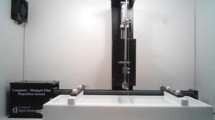Abstract
In this work, the quality of an amino-terminated SAM barrier (NH2SAM) is tested. A high density and the absence of pinholes in the barrier layer are essential for a good barrier performance in the copper interconnects. The quality of the NH2SAM layer has been assessed by water contact angle (C.A) and High resolution AFM (HR-AFM). The density and the closure of the film have been monitored by X-Ray Reflectivity (XRR), Ellipsometry and Cylic Voltametry (CV). Already for 1min deposition, the C.A value changes from <10o typical of a clean silicon oxide surface, to 51o. A 15min deposited NH2SAM (thickness <1nm, measured by XRR), results in a pinhole-free layer, as observed by HR-AFM. The refraction index (η) calculated from ellipsometry data, indicates an increase in the density of the layer with the deposition time. On the other hand, cyclic voltametry shows inhibition of the electrochemical reduction of Fe3+ to Fe2+ when NH2SAM are grafted on a 2 nm SiO2/Si electrodes. A decrease in the capacitive current is observed by increasing the layer thickness and density. The intrinsic barrier performance has been extracted from planar capacitor structures that allow measuring the leakage/Cu diffusion through the barrier in the vertical direction. The Time-Dependent Dielectric Breakdown (TDDB) lifetime results in an increase of 10 orders of magnitude of the capacitor lifetime with respect to the no-barrier control system.
Similar content being viewed by others
References
F. Schreiber, Structure and growth of self-assembling monolayers, Progress in Surface Science, 65, pp 151–256 (2000)
A. Maestre Caro et al., Bottom-up Engineering of Subnanometer Copper Diffusion Barriers Using NH2–Derived Self-Assembled Monolayers, Advanced Functional Materials, 20, 1–7 (2010) (Online pNA)
A. Maestre Caro et al., Screening self-assembled monolayers as Cu diffusion barriers Microelectronic Engineering, 85, 10, pp 2047 (2008)
G. C. Allenet al., Macro-, micro- and nano-investigations on 3–aminopropyltrimethoxysilane self-assembly-monolayers, Thin Solid Films, 483, 1–2, pp 306 (2005)
K. Awazuet al. Structure of latent tracks created by swift heavy-ion bombardment of amorphous SiO2, Physical Review B, 62, 6, pp 3689 (2000)
S. Terada, et al. Thickness and Density Measurement for New Materials with combined X-ray Technique, IEE/SEMI Advanced Semiconductor Manufacturing Conference (2001)
Soo Geun LEE et al., Low Dielectric Constant 3MS α-SiC:H as Cu Diffusion Barrier Layer in Cu Dual Damascene Process, Japanese Journal of Applied Physics, 40, pp. 2663–2668 (2001)
L. Zhao et al., A Novel Test Structure to Study Intrinsic Reliability of Barrier/Low-k, IRPS, pp848–850 (2009)
L. Zhao et al., A New Perspective of Barrier Material Evaluation and Process Optimization, IITC, pp 206–208 (2009)
Author information
Authors and Affiliations
Corresponding author
Rights and permissions
About this article
Cite this article
Maestre Caro, A., Zhao, L., Maes, G. et al. High quality NH2SAM (self assembled monolayer) diffusion barrier for advanced copper interconnects. MRS Online Proceedings Library 1249, 201 (2010). https://doi.org/10.1557/PROC-1249-F02-01
Received:
Accepted:
Published:
DOI: https://doi.org/10.1557/PROC-1249-F02-01




